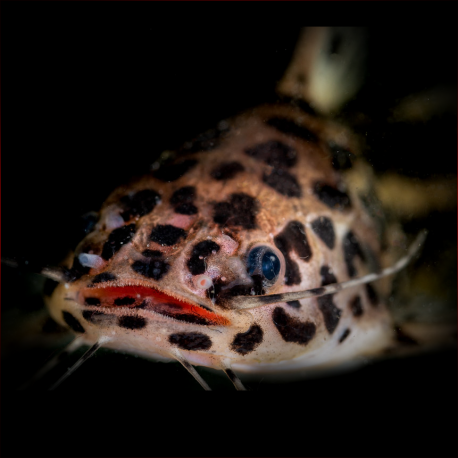More info
Datasheet
| Minimum Tank Size | 255 litres / 67.36 US gallons |
| Maximum Size | 25.0cm / 9.84inches |
| Temperature | 20°C / 68.00°F - 28°C / 82.40°F |
| Hardness | 0-15ºdH |
| pH | 4.8-7.2 |
General Description
The Jaguar Catfish, scientifically known as Liosomadoras Oncinus, is often mistaken for its close relative L. morrowi but can be distinguished by its more vibrant patterning and larger size, reaching up to 25.0cm. Originally classified under Doradidae due to its opercular spines, it has since been reclassified. Found across various waters including the Ucayali, Amazonas, and Negro river basins in Brazil, this species demonstrates adaptability to diverse water chemistries based on its collection locality.
Aquarium Setup
To adequately house the Jaguar Catfish, a minimum tank size of 255 litres is recommended. Maintaining dim lighting to suit its nocturnal nature is essential, along with providing ample hiding spots such as rocks, driftwood, PVC pipes, and low-light tolerant plants like Anubias sp., Java fern, and Vallisneria (see table). It thrives in a South American biotope aquarium alongside similarly-sized characins, cichlids, and other peaceful catfish and Loricariids.
Behaviour
Known for its shy and peaceable demeanor, the Jaguar Catfish can display territorial behavior towards other benthic species and may consume small fish during darkness. Displaying a gregarious nature, it tends to fare better when housed in small groups, especially if space permits, indicating a preference for conspecific companionship.
Feeding and Diet
This species has an unfussy palate, showing enthusiasm for live and frozen fare like bloodworms and earthworms, in addition to sinking dried foods. To ensure adequate nourishment, feeding after lights out is recommended to guarantee the Jaguar Catfish receives its fair share of sustenance.
Reproduction & Dimorphism
Reproduction of the Jaguar Catfish is not commonly observed in aquarium settings, with fertilization occurring internally. Males exhibit sexual dimorphism with a distinctively modified anal fin used akin to livebearers' gonopodium. Furthermore, mature males develop thicker dorsal and pectoral fins compared to females.
Habitat and Distribution
In the wild, the Liosomadoras Oncinus inhabits large rivers, streams, lakes, and flooded regions within the Ucayali, Amazonas, and Negro river basins of Brazil. Thriving in diverse aquatic landscapes, this species showcases apparent adaptability to various water conditions dictated by its specific collection locale.

